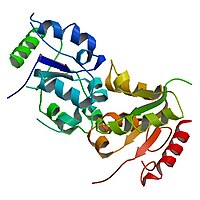
Photo from wikipedia
Toll like receptors (TLRs) are the most studied pattern recognition receptors (PRRs) as they connect the innate to the acquired immune response. To date, there are ten human TLRs which… Click to show full abstract
Toll like receptors (TLRs) are the most studied pattern recognition receptors (PRRs) as they connect the innate to the acquired immune response. To date, there are ten human TLRs which are expressed either on the plasma membrane or on the endosomes. TLR1, TLR2, TLR4, TLR5, TLR6 and TLR10 are plasma membrane TLRs that recognise extracellular components of pathogens, whereas TLR3, TLR7, TLR8 and TLR9 are located on endosomes where they recognise foreign nucleic acids. Of these TLRs, TLR10 is the latest human TLR to be discovered and its function and ligands are still unclear. TLR10 is the only known member of TLR family that can elicit anti-inflammatory effect. TLR10 can inhibit other TLRs by competing with stimulatory TLRs, dimerising with TLR1, TLR2 and TLR6, and by inducing PI3K/Akt to produce IL-1Ra. There is controversy on the function of TLR10 as an anti-inflammatory TLR as initial studies on TLR10 revealed it to promote inflammation. Herein, we review the detailed functions of TLR10 in immunity and give an account of how and when TLR10 can act on both sides of the inflammatory spectrum.
Journal Title: Handbook of experimental pharmacology
Year Published: 2021
Link to full text (if available)
Share on Social Media: Sign Up to like & get
recommendations!